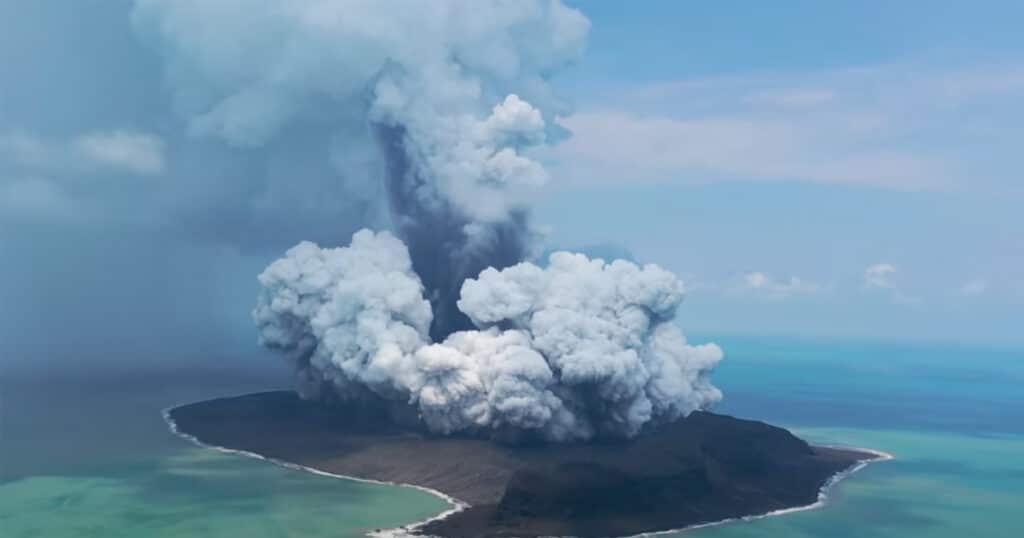
The Most Intense Lightning Storm Ever Observed by Science
Just beneath the surface of the south Pacific Ocean lies the Hunga volcano. Part of the Tonga archipelago and north of Tonga’s main island Tongatapu, Hunga lies in a very active seismic zone and has erupted four times since 1988, most recently in 2022.
The latest eruption caused a tsunami wave nearly 150 feet high that hit nearby uninhabited islands and waves over six feet tall that reached the coast of Peru. One of the largest volcanic explosions recorded since the Krakatau eruption in 1883, it produced atmospheric shockwaves that were measured as far as Europe.
These kinds of effects are commonly associated with volcanic eruptions, but Hunga added another, lesser known, feature: spectacular lightning.
Hunga produced a massive, water-rich ash plume that reached the stratosphere and generated the most intense lightning flash rates ever detected. How is it that an ash plume—not a thunderstorm—produced the most lightning ever detected?
Stratospheric lightning
Powerful volcanic eruptions produce ash plumes that can create their own weather systems, providing the conditions for lightning at higher altitudes than typically seen. In a normal cloud, electricity is generated when tiny ice particles in clouds collide. When enough charge builds up, a lightning flash occurs.
The same process happens in an ash plume, but in addition to ice collisions, silicate particles also collide and produce the charges required for lightning.
When the undersea volcano in Tonga erupted, it launched a plume 25 miles higher than typical thunderstorms. We saw lightning at stratospheric altitudes (12 to 18 miles), where the air pressure is usually too low to support thunderstorm-like lightning. This fast-rising volcanic plume may have created higher pressures to support the environment necessary for lightning.
After reaching its maximum height, the plume expanded outward as an umbrella cloud, creating fast-moving circular ripples known as gravity waves, similar to a rock dropped in a pond. Donut-shaped rings of lightning expanded with the umbrella cloud and were as large as 174 miles in diameter. Similar “lightning holes” have been observed in thunderstorms, but never on such a large scale.
Space-based optical sensors and global networks of ground-based radio antennas thousands of miles away detected the lightning.
Our group at Los Alamos National Laboratory specializes in remote sensing, meaning we develop scientific tools and methods to detect ground and space signals. This plays a pivotal role in the Laboratory’s national security mission—including nuclear detonation detection—but can also be applied to lightning detection, as lightning emits a similar signal.
We’re part of a larger team led by the U.S. Geological Survey’s Cascades Volcano Observatory, which found that the Tonga eruption produced 2,615 flashes per minute at its peak intensity. This peak lightning rate is significantly higher than the second most intense lightning event ever detected—993 flashes per minute—in a thunderstorm over the southern United States in 1999.
Remote detection of lightning helped us create a timeline of this historic eruption and demonstrated the value of using volcanic lightning for monitoring volcanic activity. Lightning observations such as these reveal detail about the evolution of an eruption over time, which is particularly valuable when cloud-cover obscures satellite observations of a plume.
Why is all of this important? Understanding volcanic lightning can help observatories monitor eruptions and forecast hazards, such as the transport of ash plumes and subsequent ashfall.
Overall, remote detection of lightning helps create a detailed timeline of volcanic eruptions and, more broadly, provides a valuable tool for predicting hazards of explosive volcanism worldwide.
This article was originally published by RealClearScience and made available via RealClearWire.



